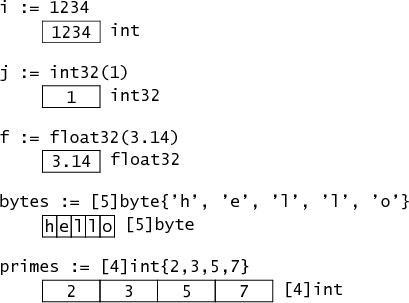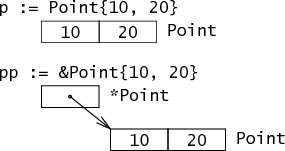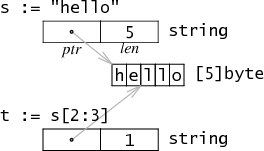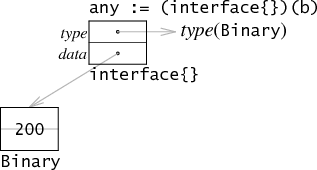Overview
As a programmer who writes a lot of go, I’m sure you see panic messages from go from time to time. Usually we can easily locate the number of lines of code in error based on the message, but because of this reason, we often overlook other information. This article is to analyze how to understand the error message output when go program panic?
Analysis by example
We start with a very simple example below.
|
|
This example will panic as soon as it runs with the following message.
|
|
-
panic: runtime error: invalid memory address or nil pointer dereference. This statement indicates that this is a panic exception and that the likely cause is an invalid memory address or nil pointer dereference. -
[signal SIGSEGV: segmentation violation code=0x1 addr=0x8 pc=0x493373].SIGSEGVis a signal sent to a process when it executes an invalid memory reference, or when a segmentation error occurs.0x1corresponds toSEGV_MAPERR, which meansaddress not found object.addris0x8, which is not a valid memory address.pcis the program counter, which is used to point to the location where the next instruction is stored. -
goroutine 1 [running].1is the ID of the goroutine.runningrepresents the state of the goroutine in case of an exception. -
main.(*Person).say(0x0, 0xc000072f58, 0x2, 0x2, 0x0).mainis the package,(*Person)is the type,sayis the method, and we can see that the call to say has a total of 5 arguments. But in the code, the call to say actually has only 1 argument.- The 1st parameter is receiver, in this case
*Person. The value0x0means it is a null pointer. - The 2nd to 4th parameter is
[]string, and as we all know, the slice data structure is composed of three fields: pointer, len, cap. pointer(0xc000072f58) is a pointer to the actual memory address, len(0x2) is the length, and cap(0x2) is the capacity. - The 5th parameter is the return value.
- The 1st parameter is receiver, in this case
-
/home/jiangpengfei.jiangpf/projects/panic_demo/main.go:14 +0x43. Here is the location of the error code and the line number. What does+0x43mean? To be honest, I didn’t find any information about it. But I found the following go runtime code [go/src/runtime/traceback.go:439]. frame is the current stack frame, f is the current function, and entry is the start pc of the function. so we know that+0x43is the pc offset on the stack.
At this point, a simple panic example has been analyzed. But there are still two things we haven’t understood here.
- How to analyze the parameters in panic. For example, as mentioned above, the slice argument will output pointer, len, and cap when panic. This means that panic will output the memory layout information of the go type. What about for other types?
- How does go runtime collect and print out all of the above information when in panic?
Memory layout of go types
The main references for this section are: Go Data Structures and Go Data Structures: Interfaces. You can also read these two articles directly.
Basic types

The memory layout of basic types is well understood and will not be elaborated.
Structs and pointers
The memory layout of structures is in the order of the member variables. Of course, there are some memory alignment optimizations, but they are out of the scope of this article.
For example, the following Point structure.
|
|
Its memory layout is as follows.

For member variables that are not basic types, the memory layout is as follows.

String

Strings consist mainly of: pointer and len, where pointer points to the first address of the byte array in memory. Also, strings in go are immutable, so it is safe for multiple strings to share the same memory area.
Slice

A slice is also a reference to a piece of memory address of an array, consisting of three fields: pointer, len and cap.
interface
(the following is based on 32-bit machines)
|
|
The Stringer type is defined above, and Binary implements the Stringer type.

Then, the memory layout of b in the figure is as follows. After doing the type conversion of b to s, the memory layout is as follows.

Here, tab refers to an itable
- the type in itable points to the underlying type (Binary), so s.tab->type gets the type of the interface.
- The func array of itable only holds pointers to methods that implement Stringer. So Get() is not stored here.
- When calling
s.String(), it is the same as callings.tab->func[0](s.data). Pass s.data as the first argument to the function call. Another thing to note here is that the function call passes in s.data, which is of type*Binary. func[0] is therefore(*Binary).Stringinstead of(Binary).String.
data is a pointer to Binary(200). Note that this does not point to the original b, but to a copy of b. Of course, this is not always the case.
Of course, this is not the case in all cases; for example, if b is converted to an interface with no methods, a little memory optimization can be done here.

In this case, since there is no func list, there is no need to allocate a separate block of memory on the heap for itable. any.type can just point directly to a type. Similarly, if data happens to be 32 bits (consistent with the machine’s addressing size), it can be optimized by storing the value directly in data.

The following are the cases where both optimizations are available.

More arguments example analysis
After understanding the memory layout of the go type above, here is a look at a function call panic with more arguments.
Note that //go:noinline is used here to prevent the go compiler from inlining the function, so that the argument information is lost after the panic. panic information is as follows.
|
|
The explanation is as follows.
If we want to see the error value without optimization. This can be run using the following.
|
|
In this case, the last two arguments are both 0x0. One more example related to structures:
|
|
The panic message after running with go run -gcflags '-N -l' main.go is as follows.
|
|
The explanation is as follows.
|
|
Execution process after a go panic
When a panic occurs on a goroutine, it enters the function exit phase. Take the manual call to panic as an example.
-
First, go runtime puts the panic at the top of the goroutine’s panic chain.
-
Then, the defer on the goroutine will be executed in turn.
-
If the deferer has already been executed before. then the defer is ignored.
1 2 3 4 5 6 7 8 9 10 11 12// If defer was started by earlier panic or Goexit (and, since we're back here, that triggered a new panic), // take defer off list. The earlier panic or Goexit will not continue running. if d.started { if d._panic != nil { d._panic.aborted = true } d._panic = nil d.fn = nil gp._defer = d.link freedefer(d) continue } -
Executes the function call corresponding to the defer.
1reflectcall(nil, unsafe.Pointer(d.fn), deferArgs(d), uint32(d.siz), uint32(d.siz)) -
If recover() is encountered in the defer function, the following code will also be executed. Of course, this will only check if the recover() call is valid.
-
p ! = nil. The current panic has indeed occurred.
-
!p.recovered. The current panic is not recovered.
-
argp uintptr(p.argp). argp is a pointer to the caller’s argument, and p.argp is an argument to defer.
-
If one of the above conditions is not met, nil is returned, indicating that this recover() is invalid.
1 2 3 4 5 6 7 8 9 10 11 12 13 14 15func gorecover(argp uintptr) interface{} { // Must be in a function running as part of a deferred call during the panic. // Must be called from the topmost function of the call // (the function used in the defer statement). // p.argp is the argument pointer of that topmost deferred function call. // Compare against argp reported by caller. // If they match, the caller is the one who can recover. gp := getg() p := gp._panic if p != nil && !p.recovered && argp == uintptr(p.argp) { p.recovered = true return p.arg } return nil }
-
-
The previous step is a recover() call, but there is no recover logic, it just marks recovered=true for the current panic, so you can execute the following judgment. The real recovery logic is executed with
mcall(recover).1 2 3 4 5 6 7 8 9 10 11 12 13 14 15 16 17 18if p.recovered { atomic.Xadd(&runningPanicDefers, -1) gp._panic = p.link // Aborted panics are marked but remain on the g.panic list. // Remove them from the list. for gp._panic != nil && gp._panic.aborted { gp._panic = gp._panic.link } if gp._panic == nil { // must be done with signal gp.sig = 0 } // Pass information about recovering frame to recovery. gp.sigcode0 = uintptr(sp) gp.sigcode1 = pc mcall(recovery) throw("recovery failed") // mcall should not return } -
Recovery is achieved as follows
1 2 3 4 5 6 7 8 9 10 11 12 13 14 15 16 17 18 19 20 21 22 23// Unwind the stack after a deferred function calls recover // after a panic. Then arrange to continue running as though // the caller of the deferred function returned normally. func recovery(gp *g) { // Info about defer passed in G struct. sp := gp.sigcode0 pc := gp.sigcode1 // d's arguments need to be in the stack. if sp != 0 && (sp < gp.stack.lo || gp.stack.hi < sp) { print("recover: ", hex(sp), " not in [", hex(gp.stack.lo), ", ", hex(gp.stack.hi), "]\n") throw("bad recovery") } // Make the deferproc for this d return again, // this time returning 1. The calling function will // jump to the standard return epilogue. gp.sched.sp = sp gp.sched.pc = pc gp.sched.lr = 0 gp.sched.ret = 1 gogo(&gp.sched) } -
If there is no recovery logic, it executes to the point where the exception message is output.
1 2 3 4 5 6 7// ran out of deferred calls - old-school panic now // Because it is unsafe to call arbitrary user code after freezing // the world, we call preprintpanics to invoke all necessary Error // and String methods to prepare the panic strings before startpanic. preprintpanics(gp._panic) fatalpanic(gp._panic) // should not return -
preprintpanicsis responsible for preparing the information to be printed. That is, if the panic argument is error, it gets the error message from v.Error(). If the parameter implements stringer, String() is called to get the string information.1 2 3 4 5 6 7 8 9 10 11 12 13 14 15 16 17 18// Call all Error and String methods before freezing the world. // Used when crashing with panicking. func preprintpanics(p *_panic) { defer func() { if recover() != nil { throw("panic while printing panic value") } }() for p != nil { switch v := p.arg.(type) { case error: p.arg = v.Error() case stringer: p.arg = v.String() } p = p.link } } -
fatalpanicstarts the final exception message output. The first recursive call toprintpanicsprints the parameters of the panic.1 2 3 4 5 6 7 8 9 10 11 12 13 14// Print all currently active panics. Used when crashing. // Should only be called after preprintpanics. func printpanics(p *_panic) { if p.link != nil { printpanics(p.link) print("\t") } print("panic: ") printany(p.arg) if p.recovered { print(" [recovered]") } print("\n") } -
Finally call
dopanic_mto print the exception call stack, and thenexit(2)to exit.